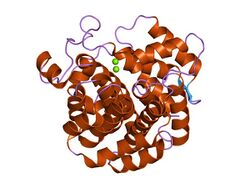Biology:ADP-ribosylglycohydrolase
| ADP-ribosylglycohydrolase | |||||||||
|---|---|---|---|---|---|---|---|---|---|
 crystal structure of ribosylglycohydrolase mj1187 from methanococcus jannaschii | |||||||||
| Identifiers | |||||||||
| Symbol | ADP_ribosyl_GH | ||||||||
| Pfam | PF03747 | ||||||||
| InterPro | IPR005502 | ||||||||
| SCOP2 | 1t5j / SCOPe / SUPFAM | ||||||||
| |||||||||
In molecular biology, the (ADP-ribosyl)hydrolase (ARH) family contains enzymes which catalyses the hydrolysis of ADP-ribosyl modifications from proteins, nucleic acids and small molecules.[1]
Types
This family has three members in humans (ARH1-3): ARH1, also termed [Protein ADP-ribosylarginine] hydrolase, cleaves ADP-ribose-L-arginine,[2] ARH2, which is predicted to be enzymatically inactive,[3] and ARH3, which cleaves primarily ADP-ribose-L-serine, but was shown to also hydrolyse poly(ADP-ribose), 1''-O-acetyl-ADP-ribose and alpha-nicotinamide adenine dinucleotide.[4][5][6][7] The family also includes ADP-ribosyl-(dinitrogen reductase) hydrolase (DraG) known to regulate dinitrogenase reductase, a key enzyme of the nitrogen fixating pathway in bacteria,[8][1] and most surprisingly jellyfish crystallins,[8][9] although the latter proteins appear to have lost the presumed active site residues.
| Class | Species | Intracellular location |
Activity | Function | ||
|---|---|---|---|---|---|---|
| Bacteria | Human | Others | ||||
| I | ARH1 | endoplasmic reticulum, cytoplasm | ADP-ribosylarginine hydrolase | inflammation, genomic stability | ||
| II | ARH2 | cytoplasm, cardiac sarcomeres | inactive | heart chamber outgrowth | ||
| III | ARH3 | Nucleus, cyoplasm | ADP-ribosylserine hydrolase | DNA repair | ||
| IV | Crystallin J1[9] and SelJ[10] | inactive | Crystallin | |||
| V | DraG | ADP-ribosylarginine hydrolase | Regulation of nitrogen fixation | |||
See also
References
- ↑ 1.0 1.1 "(ADP-ribosyl)hydrolases: structure, function, and biology". Genes & Development 34 (5–6): 263–284. March 2020. doi:10.1101/gad.334631.119. PMID 32029451.
- ↑ "Cloning and site-directed mutagenesis of human ADP-ribosylarginine hydrolase". The Journal of Biological Chemistry 268 (24): 17837–43. August 1993. doi:10.1016/S0021-9258(17)46780-9. PMID 8349667.
- ↑ "The cardiac-restricted protein ADP-ribosylhydrolase-like 1 is essential for heart chamber outgrowth and acts on muscle actin filament assembly". Developmental Biology 416 (2): 373–88. August 2016. doi:10.1016/j.ydbio.2016.05.006. PMID 27217161.
- ↑ "Serine ADP-ribosylation reversal by the hydrolase ARH3". eLife 6: e28533. June 2017. doi:10.7554/eLife.28533. PMID 28650317.
- ↑ "The ARH and Macrodomain Families of α-ADP-ribose-acceptor Hydrolases Catalyze α-NAD + Hydrolysis". ACS Chemical Biology 14 (12): 2576–2584. December 2019. doi:10.1021/acschembio.9b00429. PMID 31599159.
- ↑ "The 39-kDa poly(ADP-ribose) glycohydrolase ARH3 hydrolyzes O-acetyl-ADP-ribose, a product of the Sir2 family of acetyl-histone deacetylases". Proceedings of the National Academy of Sciences of the United States of America 103 (45): 16687–91. November 2006. doi:10.1073/pnas.0607911103. PMID 17075046.
- ↑ "Identification and characterization of a mammalian 39-kDa poly(ADP-ribose) glycohydrolase". The Journal of Biological Chemistry 281 (2): 705–13. January 2006. doi:10.1074/jbc.M510290200. PMID 16278211.
- ↑ 8.0 8.1 "Genes coding for the reversible ADP-ribosylation system of dinitrogenase reductase from Rhodospirillum rubrum". Molecular & General Genetics 218 (2): 340–7. August 1989. doi:10.1007/BF00331287. PMID 2506427.
- ↑ 9.0 9.1 "J1-crystallins of the cubomedusan jellyfish lens constitute a novel family encoded in at least three intronless genes". The Journal of Biological Chemistry 268 (16): 11894–901. June 1993. doi:10.1016/S0021-9258(19)50284-8. PMID 8505315.
- ↑ "Diversity and functional plasticity of eukaryotic selenoproteins: identification and characterization of the SelJ family". Proceedings of the National Academy of Sciences of the United States of America 102 (45): 16188–93. November 2005. doi:10.1073/pnas.0505146102. PMID 16260744.

